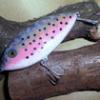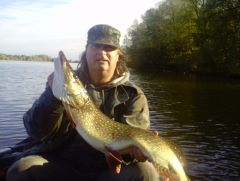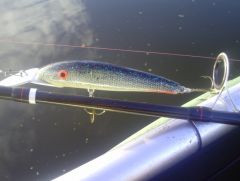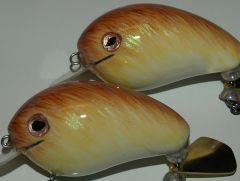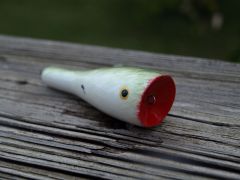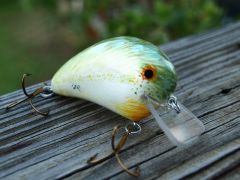-
Posts
3,867 -
Joined
-
Last visited
-
Days Won
23
Content Type
Profiles
Articles
TU Classifieds
Glossary
Website Links
Forums
Gallery
Store
Everything posted by diemai
-
@ numbskull ...............at first , welcome to the TackleUnderground" , ......good to have you here , .......and , .....second , ......thank you so much for your extensive reply , ......your write-up concerning the dynamics of such plugs is most helpful to me , ...and probably would also be to other folks in here , ...THANKS A LOT ! But I must tell you , that I would stick to my screw eyes instead of the thru-wire form , that you've suggested and which is certainly common for American striper lures , ......screw eyes are my only option , if I want to install these shifting weights which generate a better casting performance . If I'd make simple plugs without , I might do a thru-wire harness , as you've suggested , ...also for testing for different swimming actions by altering toweye position a thru-wire might come in handy . But for our local pike it's not really neccessary as well-epoxied , stainless screw eyes of 1" (belly) to 1 1/2" (front and rear) are really holding up well , ......I have greatest confidence in these . But your suggestions are still worth as gold , making my to understand the dynamics of such plugs a lot better and are helpful for my designs , ........and I will definately have a look at the sites that you've mentioned . I like these easy-built plugs for their kinda simplicity and yet their effectiveness(sooner or later I WILL catch pike on my designs ). Thanks again , ........tight lines , diemai
-
It has been one year since my last post in here , .......have fished these lures previously introduced and I'm pretty much convinced about them , ........even though I did not catch a single fish . One smaller pike took one lure by the head without engaging the belly treble , I could clearly see some marks on the virgin topcoat , ......on another bait I had a fat at least 34inch pike follow right to my feet , sadly this particular lure fell victim to a bottom snag just one hour afterwards . But my goal of design has really been accomplished , ......due to the shifting internal ballast these lures really cast quite a bit further than plugs of comparable size , .....and being a bank fisherman most likely , I really appreciate this . During past days and week I've been working on some more versions of these "WeightShifter" timber plugs , and I'm still planning for more after I would have tested these actual ones in the tub , ......maybe still room for more improvements ? Anyway , .......made a little video clip last night , ....really not saying something new compared to the previous videos made about one year ago , .......but at least I'm displaying some sketches now , probably these might help those folks interested in my design and intending to make their own ? Off course any upcoming questions will be gladly answered , .........cheers , diemai PS : By the way , ......"HappyThanksgiving" everybody over there across the Great Pond !
-
...............same at my neck of the woods , Mark , .......but luckily we're back into business ! cheers , Dieter
-
Any innovative or out-of-the box lure designs like yours are most welcome to discussion in here , ...no matter how weird they come , ..........BobP has already answered your question , ...nothing to add to it , ....except , .........welcome at TU ! Still , ....some more thoughts of mine : By chance your design might have still worked with a deep cupped Colorado Blade instead of this obviously French Blade , as these almost round Colorado blades stand away off the shaft at the biggest angle as they spin , around 75° to a bit more than 80° , I'd say , ..........probably not fouling with the lurebody's nose this way , but still the question remains , whether it would kick to get to spin at all , .........won't put my shirt on it ! Assembling the blade in a greater distance to the nose is absolutely foolproof , make sure to place enough small metal bearing beads underneath the blade's clevis and everything's gonna be fine . Also your lure has to be heavy enough to sink at a reasonable rate , ...this is because any revolving spinnerblade does provide a certain amount of lift to a lure(round Colorado Blades the most vice versa the elongated and slender Willowleaf Blades generate the smallest amount of lift) . So when the lift provided by the blade overcomes the sink rate of your lure body on retrieve , it will break through the surface sooner or later , the vortex causing the blade to work will be interrupted and it will fail to spin at this point . If your lure should not be fairly heavy enough you can only encounter this problem with a slower retrieve pace or the assembly of a smaller or more slender blade ,.....and , .....as a last option , ......frequent pausing to allow the lure to drop back . Good luck , diemai
-
-
....a close shot of my the successful homemade lure , made from abachewood with a screw-on aluminium lip . The template for this crankbait model I've photocopied from a luremaking book by the Swedish author Hans Nordin , ........made 3 or 4 of these models many years ago , some nice pike of 32" + fell for these through the years , ......these baits have a moderate wiggle and dig down to about 12 to 14 feet . Greetz , Dieter
-
Here is my best pike of this season(in fact for a few years now) , .....not the "magic meter" though , but 94 cms(scratching 38") . Was a bit dramatic to boat it , as the first attempt to put it in the net had failed , ....I was only lucky , that both hooks of my proven homemade crankbait had nailed that fish quite firmly . The successful bait is one of my earlier ones , ....maybe around 12 to 15 years old ! Thanks for your interest , ....cheers , Dieter
-
-
-
Not only the lip's size , shape , cupping and angle alone generates a certain lure action , ...also other factors like body shape , buoyancy , ballast weights , position of tow eye , etc. all have an influence on the way that a lure swims , ...all together basically refered to as "crankbait dynamics" . So your design would really depend on how you want your lure to swim in the end , ....deep or shallow , with a tight or a wide wobble , etc. What kinda metal sheet will you be using as lip material ? Good luck , diemai
-
Guess that this one decribed in following link is quite good , but I haven't yet tried it for myself yet , I'm just using simple liquid wood sealer or 50/50 mix of boiled linseed oil and turpentine(on abache wood only) : http://www.tacklemaking.com/default.php?pageID=112 There should be a lot of info on that "woodsealing" topic to be found in here as well , ........utilize the search function typing in matching keywords . If my memory serves me right , one TU member even sells these certain propionate pellets . Still I would advise you to obtain a little PVC decking sample to see , whether it works out for you or not , .......this little video put out by a friend from a German site may give you an impression how easy the refridgerator insulation stuff , that we are using over here , works down even by hand . I'm also familiar to the American "Azek" PVC trim board , I was given some samples by a TU member some time ago , its only a tad denser and heavier , but it really does not make a big difference , ........the above mentioned harder outer layer , which is only 1-2 millimetres deep , can easily be cut off on a bandsaw , if you do not wish to encounter it when carving(yes , it also carves well) . Good luck , diemai
-
Great to hear that you're OK with it , ......I was just thinking , that my own stuff(refridgerator insulation scrap pieces sold by a guy on a local forum)is somewhat more buoyant , ....makes up for 2" lures even with a bit bigger aluminium bib , thru-wired and is still able to carry a little ballast lead shot in the rear yet popping off bottom obstacles nicely. Good luck carving , .....cheers , Dieter
-
Checked the material specifications out of curiosity(I'm in Europe) ,....... to me it looks like that with a density of 0,5 to 0,6 grams per cubic centimeter it does not seem to be the most buoyant stuff(about half as heavy as water) , ......but well worth a try for medium sized and bigger bibbed lures . Cheers , diemai
-
..................absolutely great , .......what a great achievement , ...hats off to you ! cheers , diemai
-
@ mark poulson ..........thanks a lot for your expert explanations , Mark , ......live and learn ! Cheers , Dieter
-
Red Cedar is a coniferous tree , .......guess , somewhat similar to the European pinewood , that I'm more familiar to . So it should contain some kinda resin , that can react with sealer or primer coats . I remember my first glidebaits made almost 20 years ago , .....made of pinewood , the blanks soaked in a 50/50 mix of turpentine and linseed oil for a few days to seal the wood , dríed for a couple of weeks prior to priming . Some months after having completed the lures , the wood also did swell up , most likely on the thinner tail ends or nose portions to generate cracks in the paint,-and topcoat at those spots , ......even without having swum the lures at all ! Years later once I also had primer adhesion problems on pinewood dipped into ordinary liquid woodsealer , .........just trying to avoid such timbers nowadays . The way you're describing , it rather sounds to me like an adhesion problem of primer , paint and topcoat to the sealed timber rather than moisture entering the wood causing it to swell thus losing parts of the paint job , .........you're saying that even with all of those damages your lures are still performing fine . I also have some veteran topwater lures of abache wood , in use for many seasons now , ....hook rashes , stripped off paint and topcoat on some portions , teeth holes , .......all can't harm them , since they've been sealed with the linseedoil method , ...they still float up nicely season after season , not soak up water to sink or even crack up . Greetz , diemai
-
Hi , folks , Lurefishing was dead slow yesterday , just pretty much imperfect weather for successful lure fishing ! Took this rod and lure bag along first time after years of catching dust down the basement , ......usually I prefer using lighter lures and rods to be able to lure multiple species apart from pike only , ......but some folks told me , that in these heavily pressured fishing club ponds one needs bigger lures to catch better pike , so I gave it a shot . Looks like I've still gotta wait for more fall-like weather , ........colder temps , strong winds and grey skies are much better conditions for successful lure fishing and also bigger predators over here . Anyway , nothing worked out , so I thought about doing this little clip displaying my gear : tight lines , diemai
-
-
Not only the lip angle and size presets the diving depth of a lure , but also the buoancy of the lure's body . To give you an example , .......I once swapped a lure 5 1/2" blank from balsa , wanted it to dig quite deep , so I mounted a larger triangular lip pointing about 30° forward . The lure swam fine , but dug down not more than 3 feet this way , .......popped back up like a cork , if you would stop the retrieve . After I put loads of lead into belly and also back it still floated back to the surface on a pause , but much , much slower , ..........it now went down for at least 12 feet or even a tad more , .....still wobbling along seductively . You can't plan on a crankbait's action on only one of it's features alone , ....they all must match one another , and if you alter just one , you'd get a different result in entire swimming action time after time . Good luck , diemai
-
For mixing my epoxy topcoat I'm using disposable little medication jars from plastic , .......these have a millilitres scale embossed , so I can get very accurate . cheers , diemai
-
A Finnish friend does the topcoat of his lures by dipping them into congrete laquer a couple of times , ........he keeps his dip mixtures in glass jars having a spring-locked glass lid . As he once wrote to me , he also had the problem of the lid sticking to the jar , ........to overcome this little issue , he would cut out a piece of a plastic shopping bag and place it over the jar before locking down the lid onto it , .......should also seal airtight this way . Guess , that a pure white or even transparent bag would be suited best , .......who knows , whether it won't lose it's colors into the mix , .......not so important for just primer or sealer coats , though . greetz , diemai
-
@JR77 G'day , mate Can't provide a specific source , ...but check out this link list , maybe , you'd be lucky : http://www.lurefishinguk.com/links/links3.html Probably also sign in on www.lureandmore.com , .......probably your fellow countrymen there in the "homemade section" could help you out with a local source ? Cheers , diemai
-
Vic ,.... unthinned modelling dope starts to set very fast , so that on bigger lures same problems like described above by Musky Glenn might occur . The original purpose of that stuff is to be used on the paper covers of RC model wing frames of balsa , it soaks into the special paper and pulls the fibres real tight together , so that the paper layers come to sit real snug and tight over the frame under a certain grade of tension , .........therefore it's German name is "Spannlack" , meaning as much as "tension laquer" . It's available transparent , but also in a variety of different colors . I have once tried white modelling dope on sheer pinewood , but it did not adhere well , .....blame it on the resin containing in that certain timber OR the color pigments inside of the laquer , ........after curing I could just peel it off the wood . But with transparent stuff used on more or less porous balsawood such can never happen , I'm 100% sure of that , ...especially not when diluted for deeper penetration ! On another site it was also recommended to use modelling dope as a topcoat for lures meant for non-toothy fish like trout or perch , .....but it can easily affect or dissolve previously applied paintcoats due to it's strong solvent , one's gotta be cautious about this matter and try on a scrap piece first . On occassion of a visit to a model shop I've also seen a laquer there called "balsa filler" , just next to the modelling dope in their display rack , ........describition on the can said , that it would be suitable to seal and prime balsa construction parts(of aircraft models)and render them weatherproof to a certain grade , ...after fine sanding it also would provide a smooth surface for high gloss painting of the model . Maybe this stuff would be suitable for lure sealing purposes as well , ..........probably ask the staff of such shop for advice , they surely could provide better info . Over here that clear modelling dope costs about 8-9 Euros per 500ml can , ........they also sell smaller cans , but these are getting more expensive , if one puts price and contents into relation . Theres also is a special thinner available , ......bought it once in the model shop , ...but since it smelled very similar to nitro thinner , I've used that cheaper stuff from the tool mart after the special thinner was used up , ...also worked equally well . I have not used modelling dope for sealing purposes before, as I hardly do balsa baits , ......only applied a few coats over epoxy top coats , since it seemed to cure a tad harder than the epoxy I've been using by that time . But after the first pike I noticed , that the dope did not adhere well on the epoxy , .....bit by bit I could strip the layers off the epoxy , once the coat was pierced by fish's teeth . The epoxy coats underneath were not harmed , .......so a rather useless working step . So I guess , that the best purpose of the modelling dope is sealing off sheer balsa wood prior to priming and nothing else , period ! Greetz , Dieter
-
Some interesting aspects posted here , ...I was just curious , hardly doing any baits out of balsa . Especially the softer , lighter kind of balsa should be well suited to soak up any fluid laquer or glue very well . Nevertheless , ...if I was to seal off balsa blanks , I would try to dip them into some kind of diluted laquer ,......I would most likely try clear modelling dope or model builders balsa filler(primer) , both available at RC model shops for a relatively small buck . At least modelling dope dilutes easy with it's specail thinner available , ...but I guess , nitro thinner is a well suited and cheaper substitute as well , .......the stuff also can be kept in an old , airtight locking sausage glass jar for dipping and also diluting or remixing . ................gone fishing , ....cheers , Dieter



